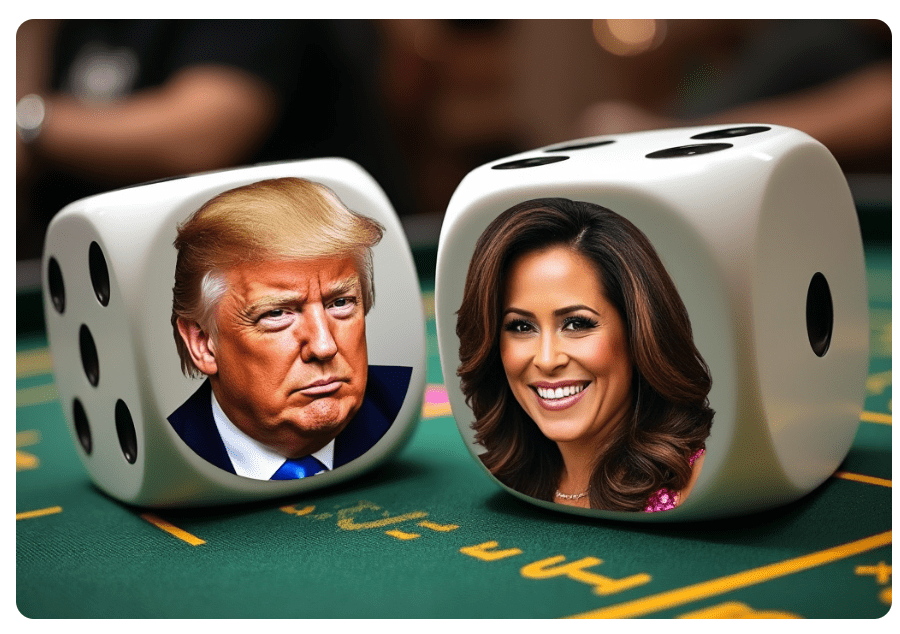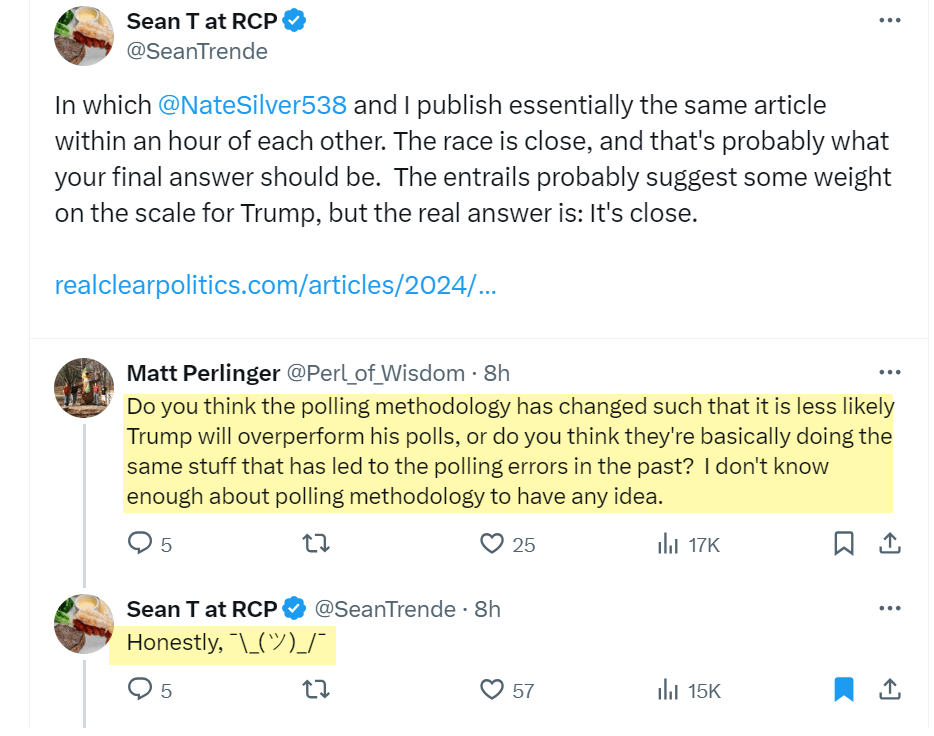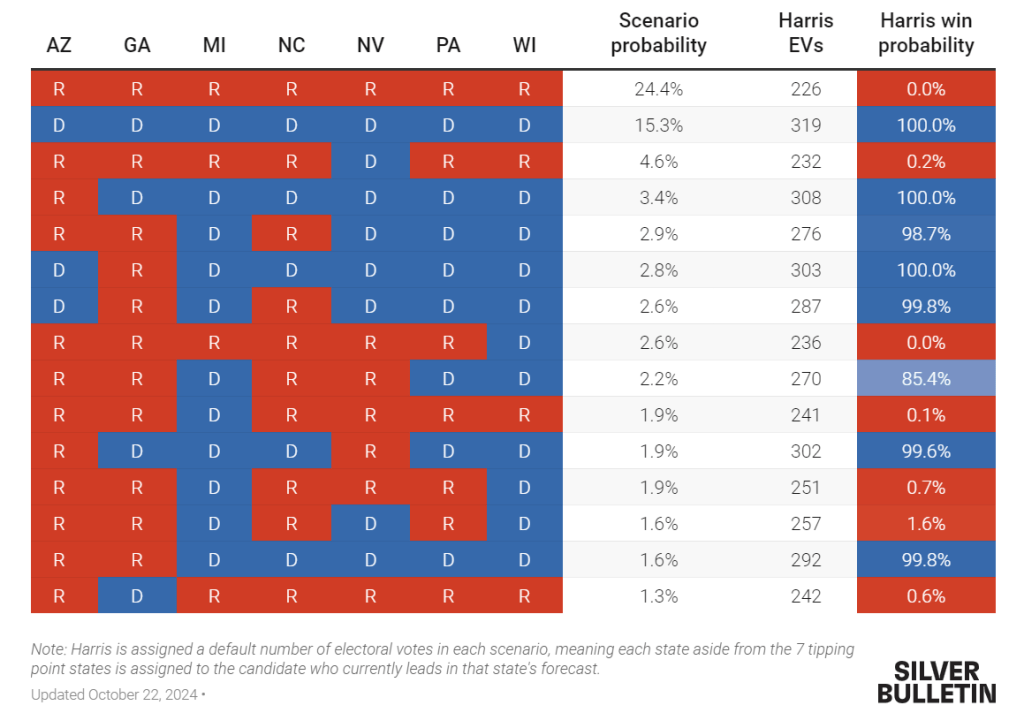Nate Silver, Nate Cohn (NYT), and Sean Trende (Real Clear Politics) all say the same thing: It’s close.

In a Tweet yesterday, Sean Trende says “Nate Silver and I publish essentially the same article within an hour of each other. The race is close, and that’s probably what your final answer should be. The entrails probably suggest some weight on the scale for Trump, but the real answer is: It’s close.”
One of my readers told me the other day to stop watching Nate Silver and start watching Real Clear Politics. OK, there you go.
Question of the Day
“Do you think the polling methodology has changed such that it is less likely Trump will overperform his polls, or do you think they’re basically doing the same stuff that has led to the polling errors in the past?”

RCP: Trump 312 over Harris 226
Republicans take comforting in the RCP projection and likely even this headline by Sean Trende, It’s Close, But the Signs Aren’t Good for Harris but read the details.
Although our poll averages show Donald Trump winning by 312 electoral votes to Vice President Kamala Harris’ 226 electoral votes, this doesn’t tell the full story. In the key battleground states, four of Trump’s leads are under a single decimal point: As of this writing, 0.8% in Pennsylvania, 0.4% in North Carolina, 0.4% in Wisconsin, and 0.9% in Michigan. Another three races show a lead of fewer than three points: Michigan (1.2), Arizona (1.8), and Georgia (2.5). It wouldn’t take a significant poll error for Harris to win.
As I give pre-election speeches and talks, though, I’m discovering that people find that answer – “It is close” – strangely unsatisfying. One thing I’ve learned through years of doing this job is that people have a difficult time dealing with uncertainty.
You can see this in the reactions as various forecasting models have shifted over the past few weeks. Over time, the difference between a 53% chance of an outcome and a 47% chance of an outcome can be meaningful.
But for a single realized outcome? The difference is effectively meaningless. This race is close. Yet crossing that 50% threshold has deep psychological meaning for people, which leads to the freakouts and recriminations that come with those thresholds being crossed.
Nevertheless, people want answers, so aside from the insistence that “it is close and could go either way, and I mean that,” I do think Trump is likely the favorite.
I’ve long believed in the rule of thumb: Watch what the candidates are doing, even more so than what the polls are saying. So ask yourself, which candidate is changing her (spoiler alert!) strategy a few weeks before the election? Kamala Harris had famously avoided impromptu interviews while she led over the summer, yet suddenly she is appearing on The View and Fox News (neither of which went particularly well). Is it a good sign that Barack Obama is on the hustings imploring black men to vote for Harris?
Second, we can look at the movement in our poll averages. It hardly matters which poll average you look at, whether it is the national polls, or Wisconsin, or Michigan, but all of them show a late break toward Trump. It would be one thing if it were just a state or two, but it really is consistent, across-the-board movement that also holds up comparing pollster-to-pollster. That gives us a fairly high degree of confidence it is “real.”
Third, there is the possibility that Trump (again) overperforms his polling. I don’t want to make too much of this. It’s true he overperformed – significantly – in 2020 and 2016. But 2020 was a weird year, to say the least, and 2016 was really an instance of pollsters’ techniques being inappropriate to the changing party coalitions.
If you’re through this thinking, “That is some thin gruel,” I agree! As I said, the real answer is, “This is a close race that could go either way.” I might add: “We probably won’t have a better sense of things until the election returns start drifting in.” I’d also note that it’s hard for me to find small “tells” pointing in the other direction. So, if I had to play a hand, I’d rather play his than hers. But the better bet for now is to just walk away from the table and wait.
It’s close. Real close.
Nate Silver’s NYT Op-Ed
For comparison purposes, please see Nate Silver’s NYT Op-Ed Here’s What My Gut Says About the Election, but Don’t Trust Anyone’s Gut, Even Mine
That’s a free link.
It’s debatable if the articles are essentially the same, but in the meme of the day, OK they are close to the same.
I am a momentum believer, and for whatever momentum has shifted. That does not mean momentum will last. It could even reverse.
I also like Trende’s discussion of what the candidates are doing. That seems real to me.
But if you look on Twitter, the overwhelming representation of what Trende reports is outright panic by the Democrats, a big stretch.
The Pollsters Blew It in 2020. Will They Be Wrong Again in 2024?
The Wall Street Journal reports The Pollsters Blew It in 2020. Will They Be Wrong Again in 2024?
Once the votes were counted in the 2020 presidential election, the result was clear: The pollsters had lost once again.
Surveys had indicated that Joe Biden was closing strong against then-President Donald Trump. He led by a comfortable 8.4 percentage points in the final Fivethirtyeight.com average of national polls just before the election, and by 7.2 points in the RealClearPolitics polling average.
Biden ended up winning the national vote by less than 4.5 points—a lead that barely let him eke out victory in the Electoral College. If polls are missing the mark this year by the same magnitude, the narrow leads for Vice President Kamala Harris in many national averages today would actually be leads for Trump.
In the aggregate, the panel said, polls overstated support for Biden by 3.9 percentage points in the national vote in the final two weeks of the campaign. That was a departure from 2016, when national polls were among the most accurate in 80 years but state-level polls failed to detect signs of Trump’s eventual victory in the Electoral College.
Scott Tranter, data science director at Decision Desk HQ, a political data firm, said some of this year’s trend-breaking developments, such as the shift of Latino and Black voters toward Trump, could cause new problems. Even if pollsters detect the shift in voting preferences among those voters, determining how many will actually cast ballots remains difficult. Similarly, a surge in suburban women who support abortion rights turning out to back Harris, should that materialize, might be hard for a pollster to foresee.
As a result, Tranter says he expects polling error to be about the same magnitude as in the recent past—but he doesn’t know if it will understate support for Trump, or for the Democratic nominee, as polls did in 2012, during then-President Barack Obama’s re-election campaign.
“It’s like a roulette wheel,” Tranter said. “Just because it showed up red the last two times doesn’t mean it’s going to show up red this time.”
That sentence by Tranter is close to what Silver said.
Silver’s Conclusion
With polling averages so close, even a small systematic polling error like the one the industry experienced in 2016 or 2020 could produce a comfortable Electoral College victory for Ms. Harris or Mr. Trump. According to my model, there’s about a 60 percent chance that one candidate will sweep at least six of seven battleground states.
Polling firms are pilloried on social media whenever they publish a result deemed an outlier — so most of them don’t, instead herding toward a consensus and matching what polling averages (and people’s instincts) show. The Times/Siena polls are one of the few regular exceptions, and they depict a much different electorate than others, with Mr. Trump making significant gains with Black and Hispanic voters but lagging in the blue-wall states of Michigan, Wisconsin and Pennsylvania.
Don’t be surprised if a relatively decisive win for one of the candidates is in the cards — or if there are bigger shifts from 2020 than most people’s guts might tell them.
I endorse that view but that does not make it an equal chance.
The Single Most Likely Battleground Result is a Clean Sweep by Trump
For those of you who think Nate Silver is a shill for Democrats, please consider this chart.

On October 22, I noted The Single Most Likely Battleground Result is a Clean Sweep by Trump
A whopping 39.7 percent of Silver’s scenarios in the battleground states are a clean sweep by Trump or Harris.
Clean Sweep or Sweep -1
- Trump: 24.4 + 4.6 + 2.6 + 1.9 + 1.3 = 34.8 Percent
- Harris: 15.3 + 3.4 + 2.8 = 21.5 Percent
Trump has a meaningful 13.3 percentage point advantage.
Trump Takes Narrow Lead Over Harris in Closing Weeks of Race
Here’s a new poll tonight not factored in Trump Takes Narrow Lead Over Harris in Closing Weeks of Race
Donald Trump has opened a narrow lead in the presidential race, as voters have adopted a more positive view of his agenda and past performance and a more negative view of Kamala Harris, a new Wall Street Journal poll finds.
The national survey finds that Trump is leading Harris by 2 percentage points, 47% to 45%, compared with a Harris lead of 2 points in the Journal’s August survey on a ballot that includes third-party and independent candidates. Both leads are within the polls’ margins of error, meaning that either candidate could actually be ahead.
The Wall Street Journal poll surveyed 1,500 registered voters from Oct. 19 to 22. The margin of error for the full sample is plus or minus 2.5 percentage points.
That’s a high quality WSJ poll.
Average that in. Silver will do so sometime today, and so will RCP.
What Went Wrong Theories
- Shy Republicans
- Something special about Trump
- Nonresponse bias
Silver says there is no evidence of shy voters. I tend to agree. In 2016 the national polls were very close but the state forecasts were abysmal.
The 2016 error has been corrected. One wonders if it’s been over-corrected.
In previous years, very few pollsters weighted on “recalled vote”. New this year almost all of them do, with NYT/Siena an exception.
Silver notes that a key problem with weighting on recalled vote is that people often misremember or misstate whom they voted for and are more likely to say they voted for the winner (in 2020, Mr. Biden).
It’s a known issues but pollsters want to improve on 2020. Instead, they may replicate 2020 but in the opposite direction.
Nate Cohn discusses what went wrong in his post Two Theories for Why the Polls Failed in 2020, and What It Means for 2024
To make polling better, you have to figure out what went wrong in the first place.
Unfortunately, no one is sure about what happened in 2020.
That’s also a free link for interested persons. Nate Cohn is always a good read.
My Take
Trump is ahead. Call it 55-45. I am a big believer in momentum. It’s real, but not overwhelming.
As, I mentioned to friends yesterday, if the polls are wrong in the opposite direction, Trump needed momentum just to get back to even.
But I would much rather be in Trump’s shoes, placing a bit of faith in the momentum. Harris’s best chance may very well be a polling error.
How confident am I there is not a big polling error? Not very, especially given the sudden switch to weighting by recalled votes.
50-50 is essentially the bottom line conclusion of Nate Silver (Silver Bulletin), Sean Trende (RCP), Nate Cohn (NYT), and various WSJ writers +- gut feeling.
What do I know they don’t?
Nothing, and you don’t either. I happen to put more weight on momentum and the other ideas of Trende than he does.
But I am not a Johnny-come-lately on momentum.
Trump’s Polling Momentum Is Real
On October 18, I commented Trump’s Polling Momentum Is Real With Under Three Weeks to Go
Let’s discuss momentum. Nate Silver mostly dismisses it, but I don’t. And the election is in 17 days.
That was followed by my October 20 post The Most Accurate Pollster in 2020 Has Blockbuster Polls for Trump
Yesterday’s WSJ poll adds to momentum. So is it 50-50 or better?
I like Trump’s chances, but this isn’t over for another 10 days, and perhaps not then. Don’t rule out either a recount or a sweep.